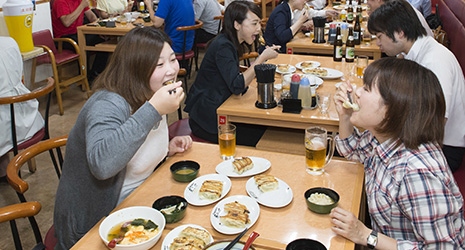Home > Highlighting JAPAN > Highlighting Japan November 2019 > Japan’s Food Culture
Highlighting JAPAN


Gyoza City
Utsunomiya in Tochigi Prefecture is leveraging its love of gyoza dumplings to pull in the crowds.
Gyoza, a Chinese dish, became popular fare in Japanese homes and restaurants after World War II. In China, gyoza—dumplings made of minced meat, vegetables and other ingredients wrapped in dough—are usually cooked by boiling. Japanese gyoza have thinner wrappers than Chinese gyoza and are typically eaten fried.
There are many gyoza specialty restaurants in cities across Japan. Yet Utsunomiya City in Tochigi Prefecture—home to some 300 restaurants serving gyoza—has had such success with its publicity campaign promoting gyoza that most people consider the city to be synonymous with the dumplings.
A nationwide household expenses survey conducted annually by the Ministry of Internal Affairs and Communications triggered gyoza’s leap into the spotlight as a popular food in Utsunomiya. In 1987, when gyoza was added to the list of survey items for the first time, the survey revealed that more gyoza dumplings were purchased per household in Utsunomiya every year than in any other city in Japan. Utsunomiya has held on to the top or second spot every year since.
“Gyoza has been a popular food with local people for a long time,” says Suzuki Akihiro, Director of Utsunomiya Gyozakai. “Gyoza have traditionally been offered at festivals and celebratory events, and it was common for hungry children to drop in at gyoza restaurants on their way home from school. However, we didn’t know that eating gyoza in this way was a custom peculiar to Utsunomiya.”
Officials at the Utsunomiya City Hall, who noticed the early survey results, thought about establishing gyoza as a meibutsu (local specialty) of Utsunomiya and asked each local gyoza restaurant to cooperate. In 1993, Utsunomiya Gyozakai was formed with the support of thirty-eight restaurants. The City and Gyozakai held events featuring gyoza and drew up a map introducing gyoza restaurants. These came to be covered often in TV programs, newspapers and magazines, earning the city nationwide publicity for its “Utsunomiya Gyoza.”
Utsunomiya Gyozakai works closely with member stores to conduct a range of promotion activities based on the policy of “competition for taste and collaboration for advertising.”
“We acquired trademark registration in the name of Utsunomiya Gyoza, but we don’t create common menus or recipes. The gyoza restaurants in Utsunomiya all have different flavors, and many people enjoy eating at different restaurants in the city to enjoy these different flavors,” says Suzuki.
The gyoza restaurant Kirasse, which is managed by Gyozakai in the center of Utsunomiya City, has a corner for the daily gyoza specials served at member stores as well as five permanent stores. Because this enables customers to enjoy the flavors of various types of gyoza at one place, Kirasse is a popular spot, where a lot of people wait in line on holidays.
In addition, “Utsunomiya Gyoza Festival” is held in a park in the city over two days every November and attracts about 150,000 visitors from Tochigi and neighboring prefectures in the Kanto Region, including Tokyo. “Utsunomiya Gyoza Festival in Yokohama” is also held every April outside the Red Brick Warehouse, a tourist attraction in Yokohama City, Kanagawa Prefecture, a long way from Utsunomiya. It is a large-scale event that attracts about 150,000 visitors over three days.
According to a survey conducted by Utsunomiya City in 2017, nine million visitors came to the city from other prefectures on an annual basis to enjoy eating gyoza. Utsunomiya City also promotes itself as a city of cocktails where leading Japanese bartenders gather, and as a city of jazz where various jazz concerts are held for local promotion making use of the popularity of gyoza. In addition, the city has professional soccer, basketball and bicycle road racing teams. On November 2 and 3, 2019, the 3-on-3 basketball club teams’ world tour final, the Utsunomiya Gyoza Festival and the jazz festival “Miya Jazz In” were held simultaneously, and the city was alive with many people.
“Using gyoza as a pillar of our activities, we want to promote the charms of Utsunomiya’s sports and culture, both within Japan and overseas,” says Suzuki.
In Utsunomiya, gyoza is a source of energy not just for the citizens but for the City itself.
© 2009 Cabinet Office, Government of Japan







